(Kalamazoo, Michigan, May 1, 1889 – Los Angeles, California May 4, 1931).1
All four of Maloney’s grandparents came to the U.S. from Ireland. His father, Michael Maloney, was born in Ohio, but moved to Kalamazoo, Michigan, where he married Margaret Daffey and set up as a dairy farmer. Clarence Bernard Maloney was the second of the couple’s four children.2
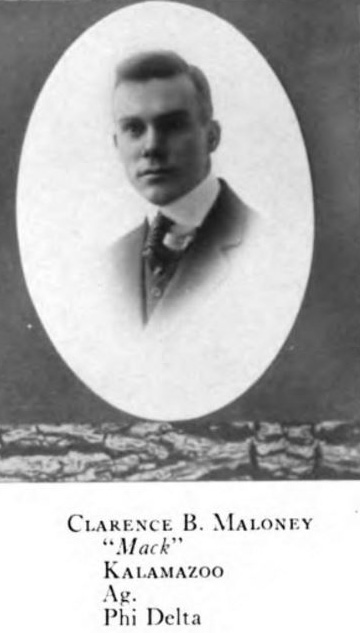
The 1910 census shows him selling milk, presumably assisting with the family business, but not long thereafter he enrolled at Michigan Agricultural College. He graduated in 1915 with a B.S. in agriculture and continued his studies at the University of Florida, where he received his M.S.3 He was employed as an inspector by the State Plant Board of Florida for a time before enlisting on June 25, 1917.4 He attended ground school at Ohio State University, graduating August 25, 1917.5
Maloney was one of the eighteen men from this class at O.S.U. who chose or were chosen for training in Italy. The men reported to the air field at Mineola on Long Island in early September, but were permitted to leave the field from time to time. Maloney and his O.S.U. classmate Parr Hooper spent one enjoyable weekend at the home of Charles Carvel Fleet, another classmate, in Dumont, New Jersey.6 A little over a week later, on September 18, 1917, they, along with the other members of the “Italian detachment,” boarded the Carmania and set out from New York for Halifax. On September 21, 1917, the Carmania left Halifax as part of a convoy for the Atlantic crossing. After an uneventful voyage the ship docked at Liverpool on October 2, 1917. There the detachment members learned, to their dismay, that they were not to go to Italy, but to remain in England, initially at Oxford. A similar, smaller group of American pilots in training had arrived at Oxford in early September; the quondam “Italian detachment” thus came to be called the “second Oxford detachment.” They spent the month of October going through ground school (again) at the Royal Flying Corps’s No. 2 School of Military Aeronautics.
The R.F.C. and American authorities were struggling to find training squadrons for the Americans at Oxford. In early November twenty men from the second Oxford detachment were able to commence flying instruction at Stamford, but the remaining men, including Maloney, were sent to Harrowby Camp near Grantham in Lincolnshire to attend machine gun school. For two weeks they trained on the Vickers machine gun and in their free time explored the surrounding countryside and towns. Early on, Maloney, along with Stanley Cooper Kerk, Joseph Kirkbride Milnor, and Guy Samuel King Wheeler, who had all been at ground school at O.S.U.,“hired a car and drove over to Nottingham about 24 miles,” where they looked around the town and had dinner, returning just before midnight curfew.6a
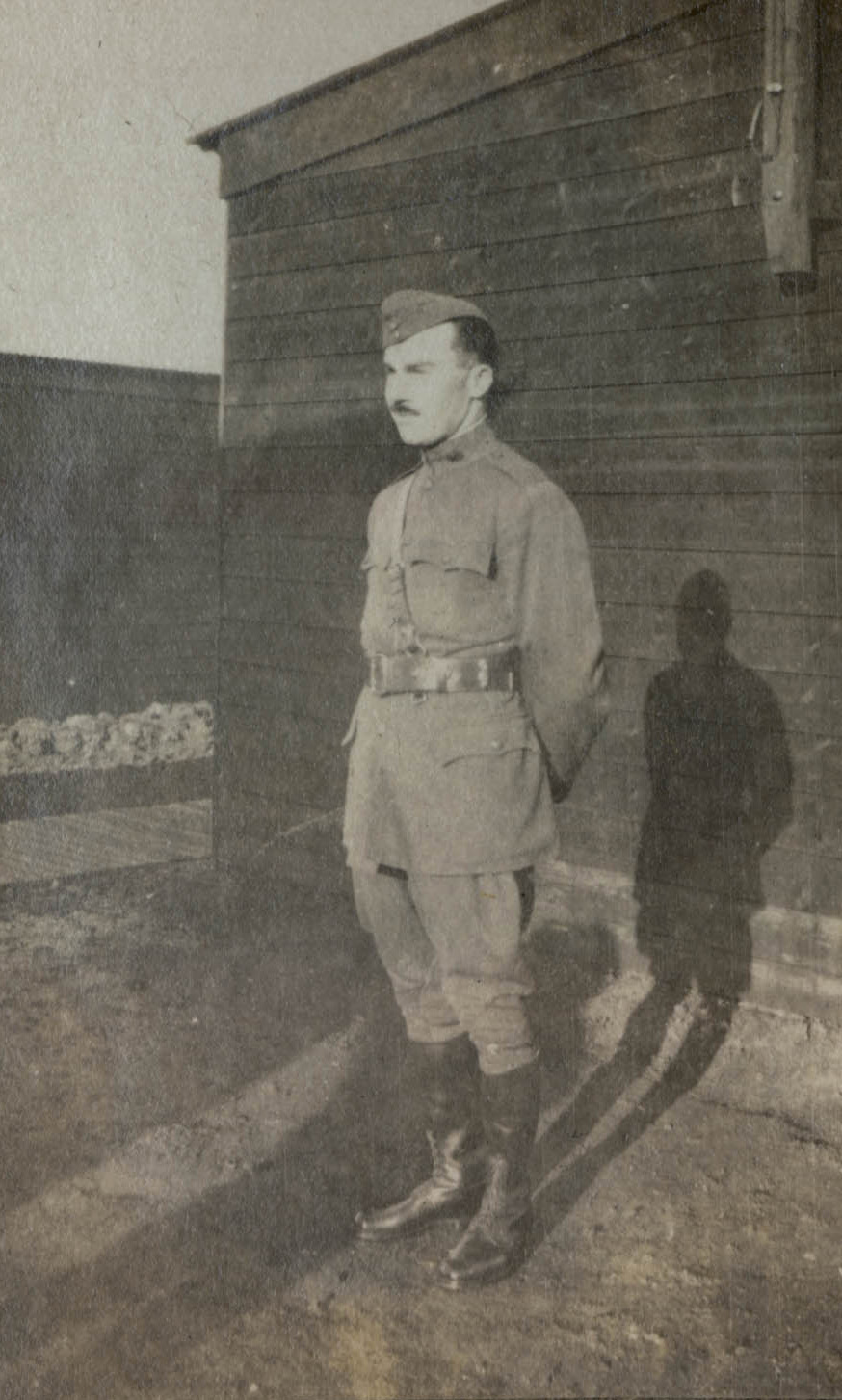
In mid-November, fifty of the men were posted to squadrons. The evening before they left, some of the O.S.U. classmates “had a ‘Columbus’ farewell party at the George” that included Milnor, Hugh Douglas Stier, and Roland Hammond Ritter, who were leaving, and Charles Carvel Fleet, Wheeler, and Maloney who were to remain at Grantham and practice on the Lewis machine gun for two weeks..6b
Thanksgiving was taken as an opportunity to celebrate. The Americans were joined by British officers, and men from the detachment already at training squadrons returned to Grantham for the occasion. Prior to the turkey dinner, there was a football game between teams of second Oxford detachment men at Grantham, the “Unfits” and the “Hardly Ables.” Maloney played for the winning Unfits, and his team mate, Lloyd Ludwig, commented that “Mac [Maloney], Kerk, [George Atherton] Brader and [Temple Paul] Hardin played great games.”7 Maloney appears in photos of the winning team.
A few days later, all the men still at Grantham were finally posted to R.F.C. squadrons. According to a list drawn up by Fremont Cutler Foss, Maloney was assigned to No. 112 Squadron, a home defense squadron at Throwley in Kent, along with his fellow O.S.U. classmates Fleet and Guy Samuel King Wheeler, as well as Leslie Alfred Amzia Benson, Francis Joseph Hagan, and William Henley Mooney.8
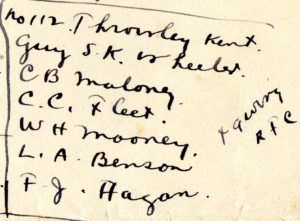
No. 112 flew Camels, which, of course, could not be used for primary instruction. There must also, however, have been some two seaters; Fleet wrote to Hooper from Throwley that the cadets “are billeted in nice homes and do not do anything except occasional flying when the pilots feel like taking them up.”9 Maloney’s sketchy R.A.F. service record indicates that on January 26, 1918, he was transferred from No. 112 Squadron to Stamford.10 Fleet and Mooney were also assigned to Stamford, as were their fellow second Oxford detachment members Clayton Knight and Robert Thomas Palmer.11 At Stamford—probably No. 5 Training Depot Station at Easton on the Hill about two miles south-southwest of Stamford—Maloney would finally have begun actual flying instruction, perhaps initially on B.E.2e’s.12 Assuming his training resembled that of Knight, he would have moved on to B.E.2c’s and R.E.8s, both of which were two-seater planes used for reconnaissance and bombing.13
After a little more than two months of training to fly, Maloney, along with a large number of his fellow second Oxford detachment members, was recommended for his commission as a first lieutenant. Pershing’s cable forwarding the recommendation to Washington is dated April 8, 1918; the confirming cable is dated over a month later, May 13, 1918. More delays meant that Maloney was not placed on active duty until towards the end of the month.14 On May 31, 1918, Fleet wrote to Benson, having heard about “you fellows getting commissions. Mac & I got terribly stewed too. It isn’t every day one get[s] a commiss[ion], is it, I ask you? 15
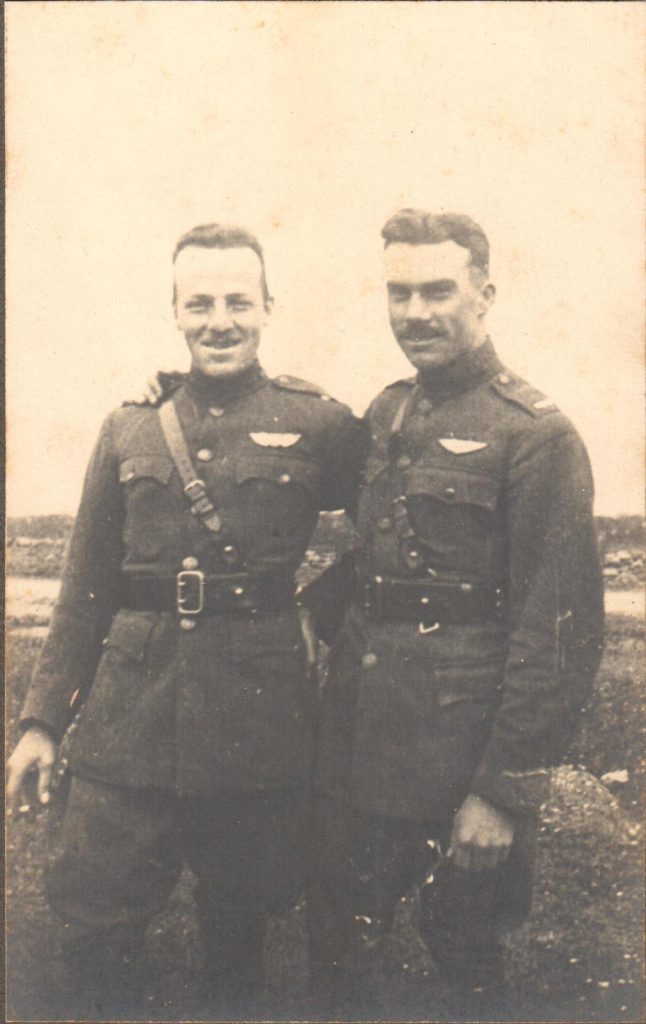
It was perhaps around this time that a photo was taken of Fleet and Maloney, both grinning and sporting the pilot’s wings they were now permitted to wear. Fleet also remarks that “I suppose you know Bill [Mooney], Mac, Palmer & Knight have gone to 128 T.S. Thetford.” The four pilots actually went not to a training squadron, but to No. 128 Squadron R.A.F., which was at Thetford. Assuming that Maloney’s training resembled that of Knight (and Palmer), he would have “transitioned from B.E.’s to D.H.6’s, R.E.8’s and, ultimately to D.H.9’s.”16
There is no reliable documentation of Maloney’s postings and service after Thetford. There are brief mentions of an American “Lt. Maloney” serving as a Camel ferry pilot in June of 1918.17 Given, however, Maloney’s known training, it seems unlikely that he would have been asked to fly Camels. A brief biography of him in a 1920 publication about Kalamazoo men in the war reports that he was “assigned to 95 Sqdn. Royal Air Force at St. Omer, France; injured in flying accident at Marquis[e], France, Oct. 11, 1918.”18 No. 95 Squadron was disbanded in July 1918 before it became operational; it began to reform early in October 1918, but was never stationed in France, so the source is apparently mistaken.19 That, however, Maloney was injured or fell ill is substantiated by his R.A.F. service record, which states that he was admitted to hospital in Norfolk on November 21, 1918.20
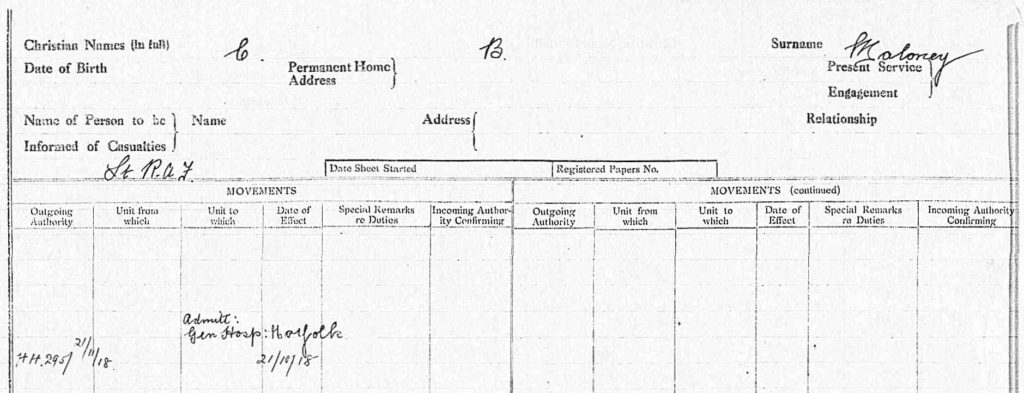
He was among a detachment of sick and wounded transported from Liverpool back to the U.S. on the Celtic in December 1918.21 Once recovered, Maloney studied law and architecture at Columbia University.22 He traveled to Europe with his young daughter in 1925.23 The 1930 Census records him working in real estate in California, where he died the next year.24
mrsmcq June 28, 2019; updated August 25, 2020, to reflect Milnor diary
Notes
(For complete bibliographic entries, please consult the list of works and web pages cited.)
1 On Maloney’s place and date of birth, see Ancestry.com, U.S., World War I Draft Registration Cards, 1917-1918, record for Clarance [sic] Bernard Maloney. On his place and date of death, see Ancestry.com, California, Death Index, 1905-1939, record for Clarence B Maloney. The photo is a detail from a group photo of his O.S.U. ground school class.
2 On Maloney’s family, see documents available at Ancestry.com.
3 See Ancestry.com, 1910 United States Federal Census, record for Clarence Maloney. For his undergraduate degree year, see “Alumni Notes” (The M.A.C.), p. 10. Columbia University, Directory of Officers and Students 1922-1923, p. 247, indicates the degree was a B.S. and records his M.S. from Florida.
4 For Maloney’s employment, see Newell, “Report of the Plant Commissioner,” p. 114. For his enlistment date, see An Honor Roll: Containing a Pictorial Record of the War Service of the Men and Women of Kalamazoo County, 1917-1918-1919, p. 146.
5 “Ground School Graduations [for August 25, 1917].”
6a Milnor, diary entry for November 4, 1917.
6b Milnor, diary entry for November 18, 1917.
7 Ludwig, diary entry for November 29, 1917.
8 Foss, Papers, “Cadets of Italian Detachment Posted Dec 3rd.”
9 Hooper, Somewhere in France, letter of December 18, 1917.
10 The National Archives (United Kingdom), Royal Air Force officers’ service records 1918–1919, record for C. B. Maloney.
11 This is inferred from remarks in a letter from Fleet to Benson dated May 31 [1918] in the Leslie A. A. Benson Collection, 1917-1919.; and from a remark about Mooney’s training made by Knight, cited on p. 206 of Kilduff, “Clayton Knight—Artist & Airman.”
12 I initially assumed that Maloney was at No. 1 T.D.S. at Stamford, where twenty men from the second Oxford detachment had been posted from Oxford. But it is more likely that his assignment paralleled that of Palmer, who went to 5 T.D.S.
13 See the description of Knight’s training on p. 206 of Kilduff, “Clayton Knight—Artist & Airman.”
14 See cablegrams 874-S and 1303-R, and McAndrew, “Special Orders No. 147”and “Special Orders No. 205.” Cablegram 874-S specifies that the men were to be appointed “First Lieutenants Aviation Reserve non flying.” See here for an explanation of the non-flying status.
15 Letter from Fleet to Benson dated May 31 [1918] in the Leslie A. A. Benson Collection, 1917-1919.
16 Kilduff, “Clayton Knight—Artist & Airman.” See also Palmer’s Pilots Flying Log Book on Palmer’s time at Thetford.
17 See History of London Branch of the Supply Section and of Liquidation Section, chart 3, as well as the entry for F1380 in Sturtivant and Page, The Camel File.
18 An Honor Roll: Containing a Pictorial Record of the War Service of the Men and Women of Kalamazoo County, 1917-1918-1919, p. 146.
19 Philpott, The Birth of the Royal Air Force, p. 421.
20 The National Archives (United Kingdom), Royal Air Force officers’ service records 1918–1919, record for C. B. Maloney.
21 See Ancestry.com, U.S., Army Transport Service, Passenger Lists, 1910-1939, record for Clarence B. Maloney.
22 See Columbia University in the City of New York, Directory of Officers and Students 1922-1923, p. 247.
23 See Ancestry.com, U.S. Passport Applications, 1795-1925, record for Clarence Benard [sic] Maloney; and Ancestry.com, New York, Passenger Lists, 1820-1957, record for Clarence Maloney.
24 Ancestry.com, 1930 United States Federal Census, record for Clarence B Maloney.

